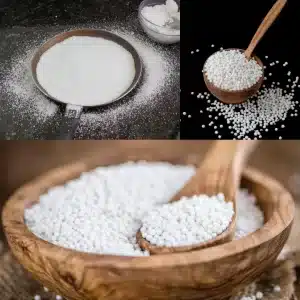The Allure of Tapioca: Origins, Varieties, and Culinary Delights
Dive into the fascinating world of tapioca
Tapioca: An Incredible Ingredient
Tapioca, a versatile ingredient beloved by many around the world, holds a rich history and a myriad of culinary applications.
Known for its unique texture and subtle flavor, tapioca is derived from the cassava plant, a tropical root native to South America.
This article delves into the origins of tapioca, explores its various types, and celebrates its place in global cuisine.

Origin of Tapioca: From Roots to Global Fame
Tapioca’s journey begins in the lush regions of the Amazon basin, where indigenous peoples have cultivated cassava for thousands of years. Cassava, also known as manioc or yuca, is a staple in many tropical countries due to its adaptability to various climates and soils. The process of extracting tapioca involves peeling, grating, and washing the cassava root to separate the starch, which is then dried into pearls, flakes, or flour.
The word “tapioca” is derived from the Tupi-Guarani language of Brazil, reflecting the ingredient’s deep roots in South American culture. Portuguese explorers introduced cassava and its derivatives to Africa and Asia during the 16th century, where it quickly became an essential part of the local diets due to its versatility and nutritional value.
Types of Tapioca: Diverse Forms and Uses
Tapioca appears in various forms, each lending itself to different culinary applications. Here are some of the most common types:
Tapioca Pearls: Small, round balls made from tapioca starch, these pearls are most famously used in bubble tea, a popular Taiwanese beverage. They are also used in desserts such as tapioca pudding, where they provide a delightful chewy texture.
Tapioca Flour: A gluten-free flour that is invaluable in baking, especially in gluten-free recipes. It acts as a thickening agent in soups, sauces, and pie fillings, providing a smooth and glossy finish.
Tapioca Sticks and Chips: These are often fried or baked to create crispy snacks, similar to potato chips. In various cultures, they are seasoned with spices for an added flavor kick.
Tapioca Granules: Used in cooking and baking, these granules are similar to small pearls but typically cook faster and are used to add texture to dishes.
Tapioca in Global Cuisines
Tapioca’s neutral flavor and versatile texture make it an ideal ingredient in a wide range of dishes across different cuisines. Here are a few examples:
Brazil: Known as “tapioca,” this dish consists of flatbreads made from tapioca flour, filled with savory or sweet ingredients like cheese, coconut, or chocolate. It’s a beloved street food and breakfast item.
India: Tapioca is used in dishes like “sabudana khichdi,” a savory dish prepared with tapioca pearls, peanuts, and spices, commonly enjoyed during fasting periods.
Thailand: Tapioca is featured in desserts such as “sakoo,” small tapioca pearls cooked with coconut milk and sugar, often served with ripe mango.
Africa: Cassava is a staple food, and tapioca is used in various forms, including flour and thickening agents, to create porridges and soups.
The Nutritional Aspect of Tapioca
While tapioca is primarily a carbohydrate source, it is gluten-free, making it an excellent alternative for those with gluten sensitivities or celiac disease. However, it is low in protein, fiber, and other nutrients, so it is often combined with other nutrient-dense foods in dishes.
The Future of Tapioca: Innovative Uses
As interest in gluten-free and plant-based diets continues to grow, so does the exploration of tapioca in innovative culinary applications. From vegan cheese and gluten-free bread to tapioca-based noodles, the potential uses of tapioca are expanding, making it a staple in modern kitchens around the globe.
Conclusion: Tapioca’s Timeless Appeal
Tapioca stands as a testament to the enduring legacy of the cassava plant, its adaptability, and its ability to connect diverse culinary traditions. From its humble origins in the Amazon to its global presence today, tapioca continues to inspire chefs and home cooks alike with its unique properties and wide-ranging applications. Whether enjoyed in a refreshing bubble tea or a comforting bowl of tapioca pudding, this remarkable ingredient remains a cherished part of the culinary world.
With its rich history, diverse types, and wide-ranging culinary uses, tapioca offers endless possibilities for exploration and enjoyment. As you experiment with tapioca in your kitchen, you’ll discover its ability to transform simple ingredients into delightful and satisfying dishes, embodying the creativity and adaptability of global cuisine.